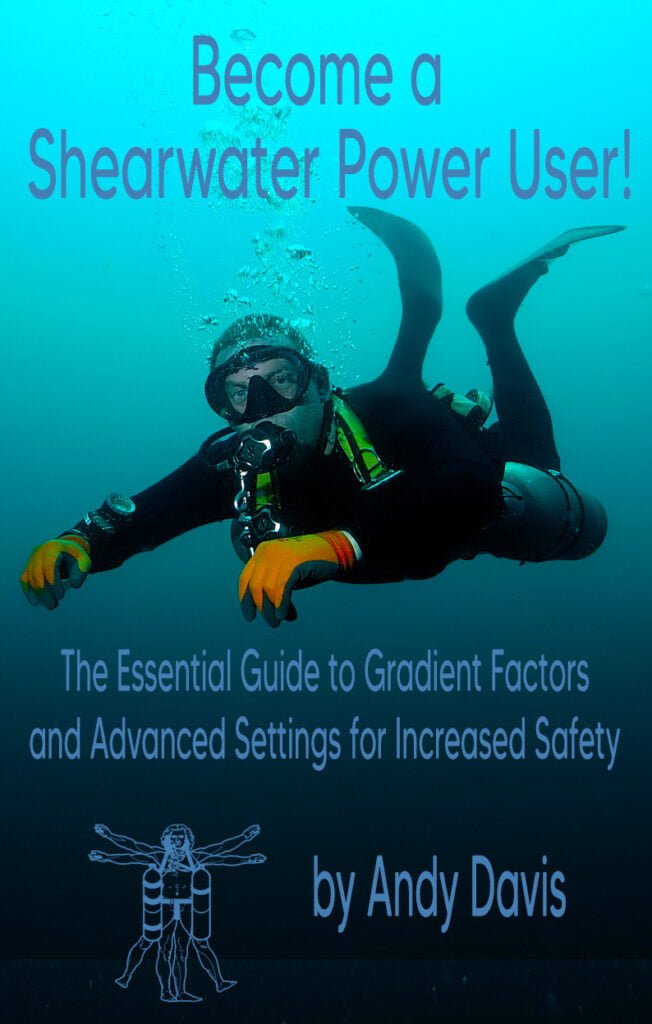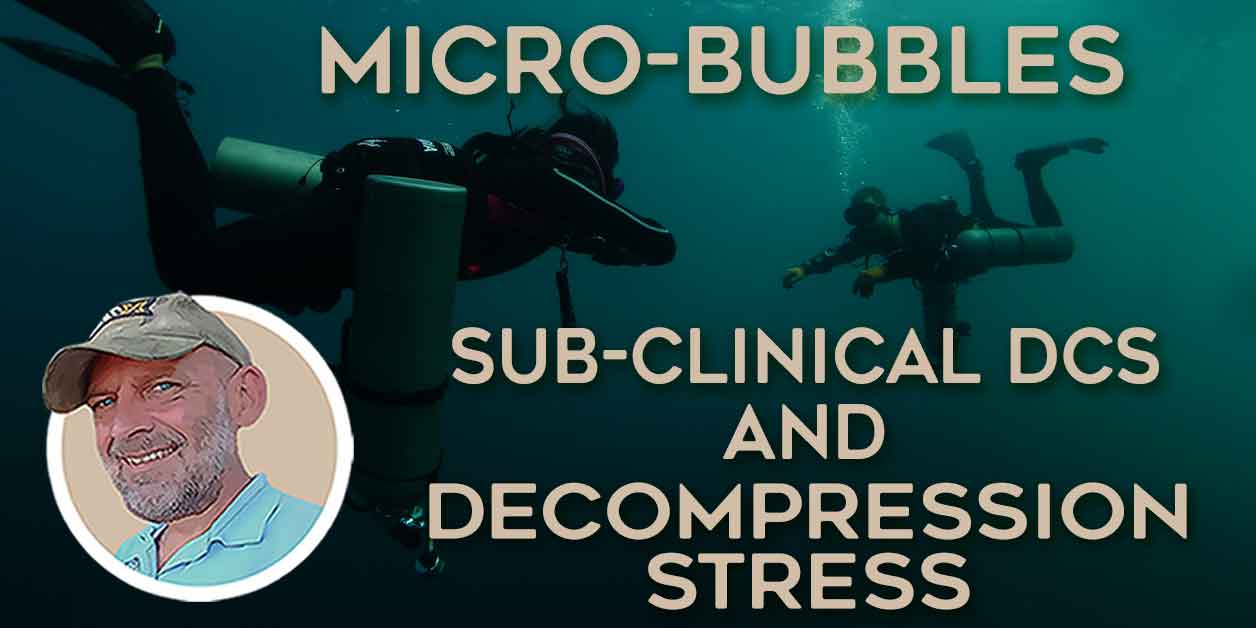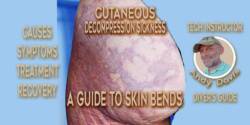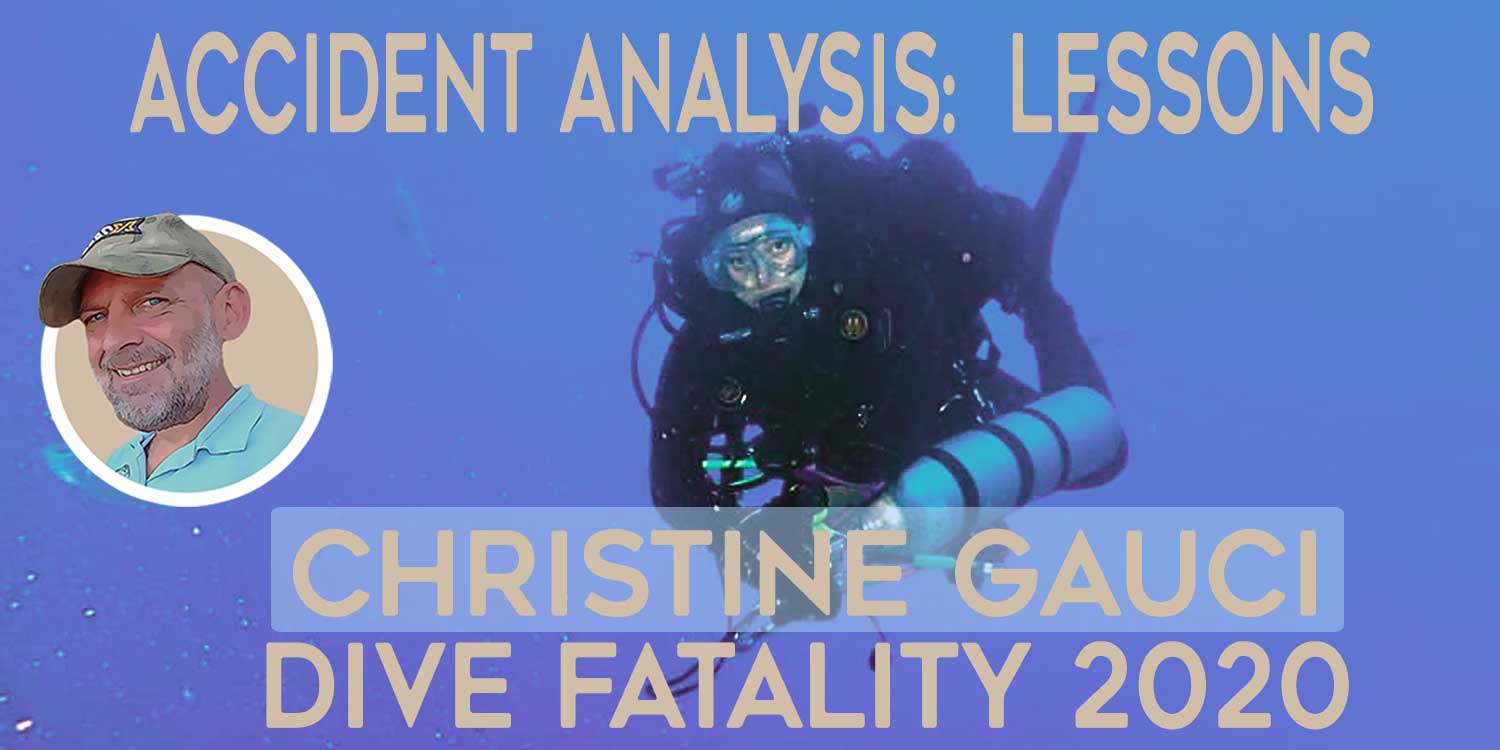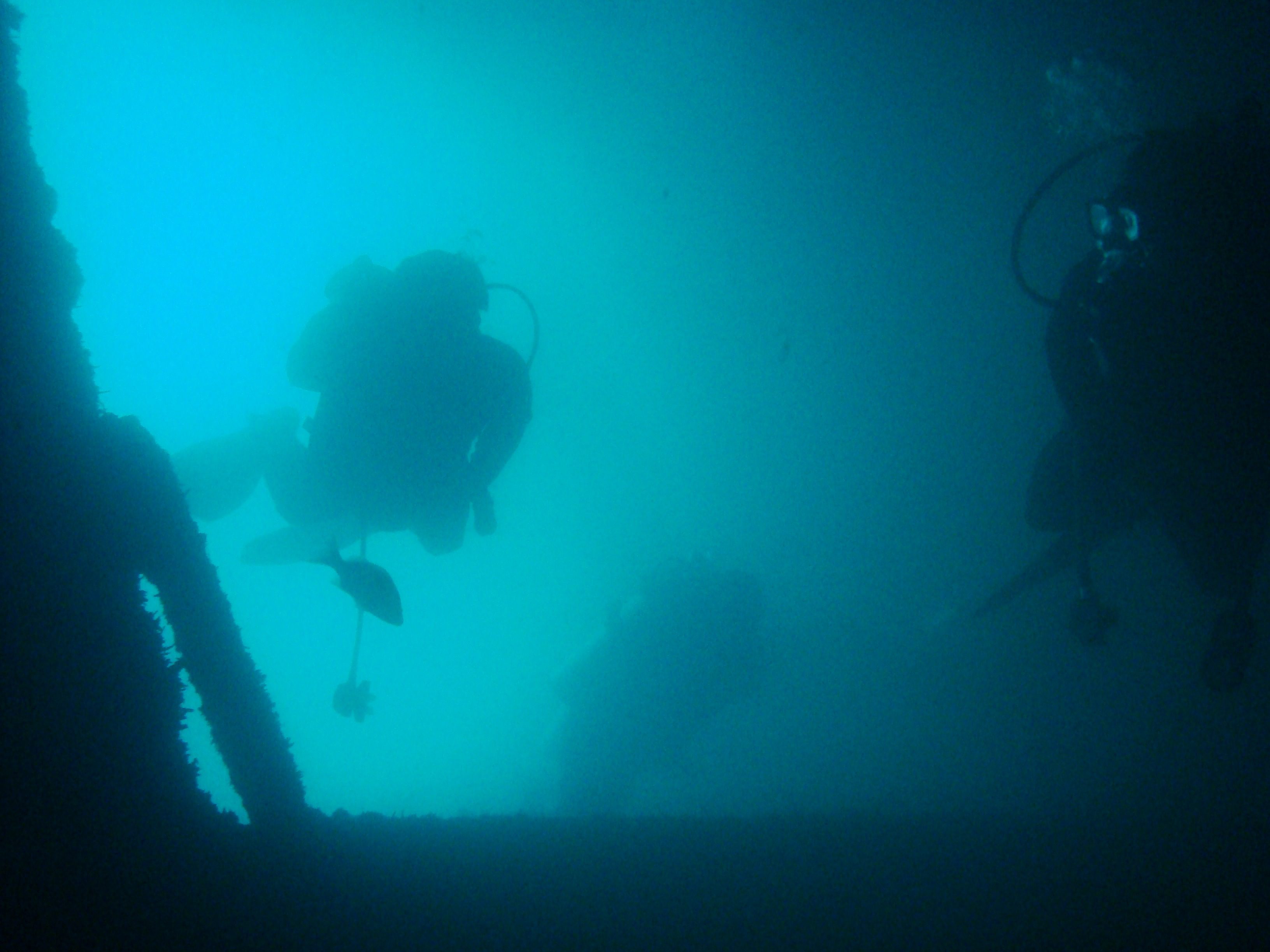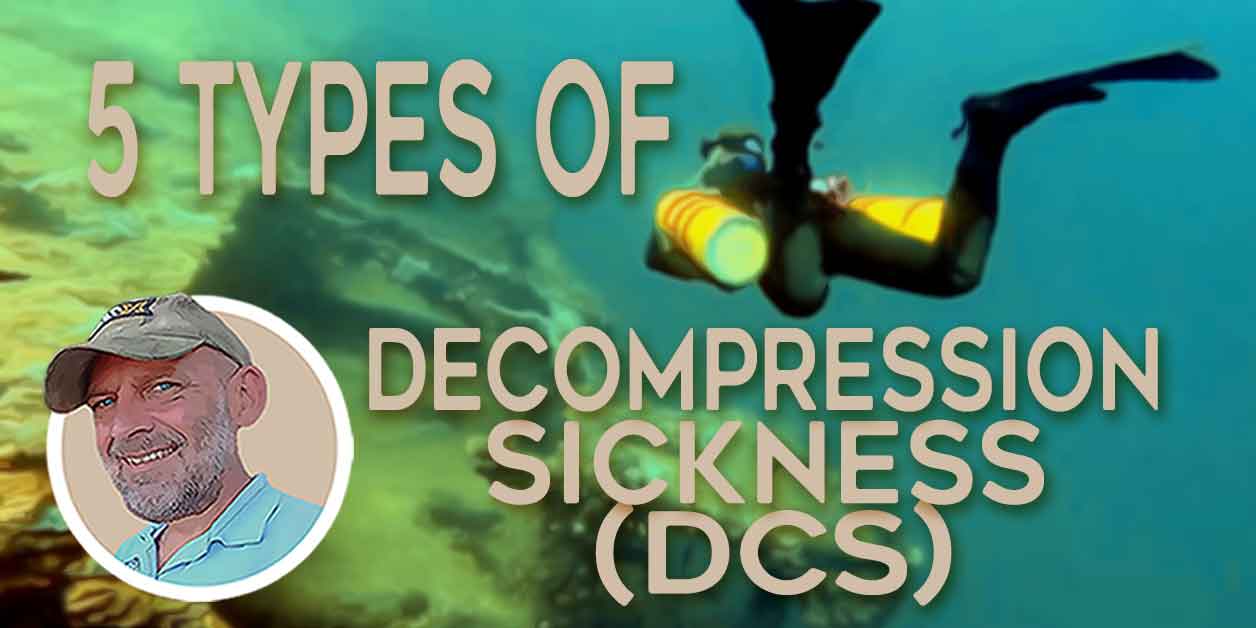Undeserved Bends: The Facts and the Myths of Unexplained DCS Hits
In the diving community, the concept of “undeserved bends” (undeserved decompression sickness) still persists as a way for divers to rationalize unexplained incidents of the bends. Many DCS victims think, “But my computer said I was safe!” after suffering from decompression sickness.
Ultimately, decompression sickness (DCS) is a result of insufficient decompression. Simply staying within the limits of dive computer conservatism settings, or ensuring that you don’t ascend too rapidly, are not the only factors that prevent bends. Hyperbaric doctors might not be able to explain why the diver conducted insufficient decompression on a given day, but that is different from a bend being “undeserved”.
Understanding why “undeserved” is an emotionally comforting, yet technically flawed label is essential for advancing your knowledge of decompression safety. This article delves into the facts and myths surrounding “undeserved bends”, explaining why many DCS cases deemed “undeserved” can be clarified through a deeper understanding of decompression theory, individual physiological factors, and real-world dive profiles.
The Misleading Comfort of “Undeserved” in Decompression Sickness
Describing a case of DCS as “undeserved” typically reflects emotional frustration rather than a technical reality. The term implies that the diver did everything correctly according to the algorithm or dive computer, so a DCS hit must be a malfunction or mystery. However, modern decompression models are built on limited data sets and offer general predictions. They serve as useful but imperfect guides; they cannot account for all the variables that might lead to decompression stress.
To begin with, decompression algorithms largely depend on two main factors: time and pressure. This simplistic approach, while adequate for a general framework, fails to capture the complexity of individual physiology, dive-specific conditions, and numerous environmental factors. Dr. Neal Pollock, a renowned diving physiologist, underscores that many so-called “undeserved” DCS cases are merely the outcome of divers placing too much faith in algorithms rather than acknowledging their limitations and planning accordingly.
So, is “undeserved” an accurate descriptor? According to Pollock, it’s not. In fact, the term “undeserved” often undermines our understanding of decompression sickness by reducing complex factors to mere anomalies. It’s essential for divers to replace this notion with a mindset geared toward risk management, recognizing that decompression models are rough approximations, not definitive safety guarantees.
Why DCS Incidents Appear “Undeserved”
Research indicates that around 40% of DCS cases occur under conditions where divers have strictly followed guidelines. They didn’t miss decompression stops or perform rapid ascents, and they enabled conservative settings on their computers. However, decompression sickness can still develop due to a variety of factors, some of which are currently beyond the predictive scope of decompression algorithms.
The truth is that every decompression model—whether based on Bühlmann, VPM, RGBM, or other frameworks—relies on limited parameters. These models attempt to approximate the body’s response to pressure changes based on collective data rather than individual physiology. Consequently, they provide only a first-order approximation of DCS risk, with a potential margin of error that leaves room for unexpected outcomes.
To better understand what can cause decompression sickness, divers should consider a wider array of influences, including physical activity, thermal status, hydration levels, genetic factors, and individual physiology. Let’s explore these contributing factors in detail.
Understanding DCS Susceptibility as a Bell Curve Distribution
DCS susceptibility could be imagined as a bell curve distribution, illustrating the range of responses among divers to decompression. This distribution highlights how individual susceptibility varies, with most divers clustering around an average level of risk, while a smaller percentage displays either high or low susceptibility.
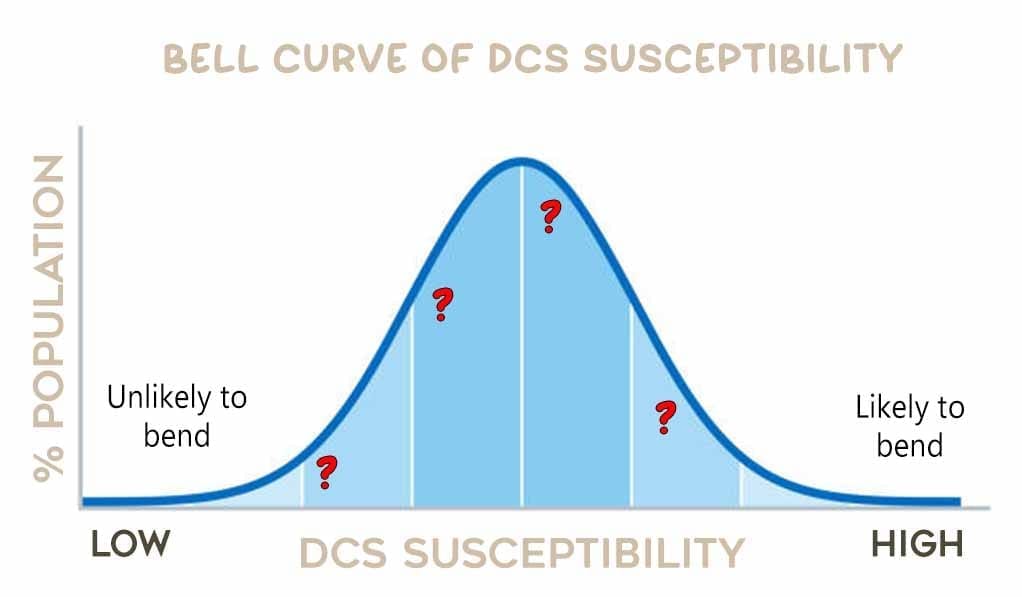
Key Components of the Bell Curve
- Normal Distribution: The bell curve represents a normal distribution, where the x-axis reflects susceptibility levels and the y-axis indicates the number of divers. Most divers have a susceptibility close to the mean, creating the characteristic bell shape.
- Variability Among Divers: The spread of the curve captures the variability in how different divers respond to decompression. Factors contributing to this variability include physiological differences, diving experience, and environmental conditions.
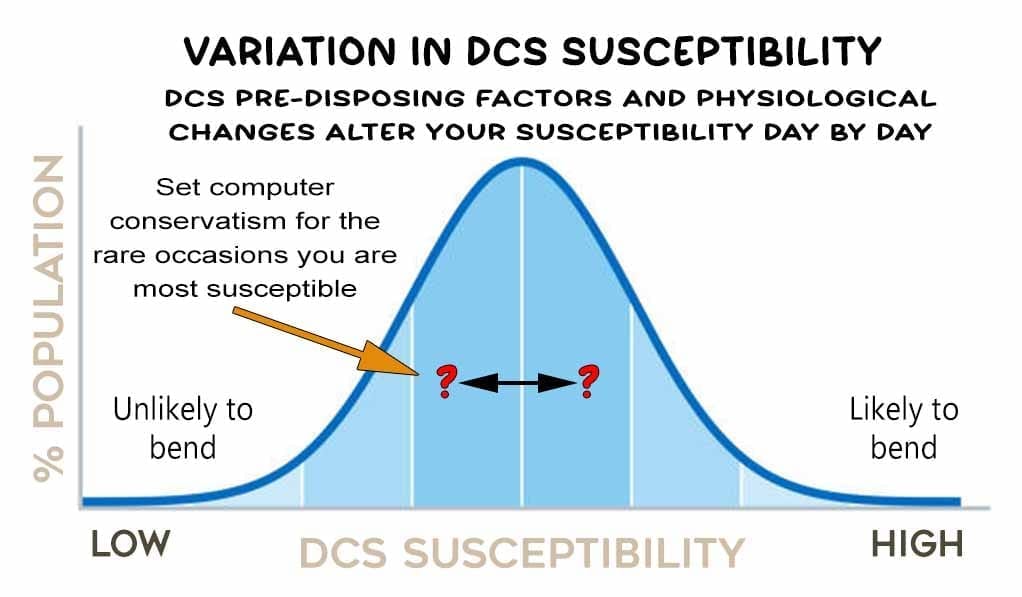
Day-to-Day Variation in DCS Susceptibility
- DCS Predisposing Factors: Many external and internal factors can predispose a diver to DCS on any given day.
- Physiological Changes with Age: As divers age, physiological changes can further influence their susceptibility:
- Circulatory Health: Aging can lead to decreased vascular elasticity and circulation efficiency, potentially hindering nitrogen removal from the body.
- Body Composition Changes: Increased body fat percentage and decreased muscle mass can alter how nitrogen is stored and released, impacting DCS risk.
- General Health Conditions: The prevalence of age-related health issues, such as cardiovascular problems or joint conditions, can also increase DCS susceptibility.
DCS Susceptibility and Undeserved Bends
Understanding DCS susceptibility as a bell curve emphasizes that not all divers are equally affected by decompression protocols. It highlights the importance of individualized dive planning based on current physiological conditions, experience, and environmental factors.
- Personalized Approach: Divers should consider their current physical state before each dive, taking into account hydration, fatigue, and any recent illnesses.
- Regular Assessments: Monitoring physiological changes over time can help divers recognize trends that may affect their susceptibility to DCS.
The bell curve distribution of DCS susceptibility illustrates the inherent variability among divers. Day-to-day factors, such as hydration and fatigue, as well as age-related physiological changes, can significantly influence an individual diver’s risk profile. By recognizing these factors, divers can take proactive steps to manage their susceptibility and enhance their safety during dives.
Predisposing Factors Influencing Undeserved Bends
1. Exercise Before, During, and After the Dive
Physical exertion can significantly influence inert gas absorption and elimination. Exercise before a dive may influence how the body handles nitrogen uptake later, while exertion during the dive affects gas uptake and decompression sickness in various ways:
- Pre-dive Exercise: Exercise before a dive may increase circulation, potentially increasing the body’s tendency to absorb nitrogen during the descent and bottom phases.
- During Descent and Bottom Time: Exercise increases blood flow to tissues, promoting nitrogen absorption. This leads to heightened decompression sickness as the body attempts to offload this nitrogen.
- During Ascent and Stops: Light exercise during ascent and decompression stops can aid nitrogen elimination by promoting blood flow. However, excessive exertion during these phases can facilitate bubble formation, ironically increasing the risk of DCS.
2. Thermal Factors During the Dive
Thermal conditions, often underestimated in their impact, play a substantial role in gas absorption and decompression:
- Warm on Descent and Bottom Phase: Being warm during the initial dive phase promotes blood flow and gas exchange, potentially increasing inert gas uptake.
- Cool on Ascent and Stops: Staying cool during ascent inhibits blood flow, decreasing gas elimination rates and heightening decompression sickness. In contrast, moderate warmth promotes circulation, helping to offload nitrogen efficiently.
Like exercise, these thermal effects are difficult to control precisely during a dive, especially as water temperature and diver insulation vary. Yet, divers should be mindful of the effect of temperature, recognizing that being overly warm or cold can shift their risk profile.
3. Dehydration: Scapegoat or Genuine Risk Factor?
Dehydration is frequently cited as a DCS risk factor, though its impact is often overstated. The effect of dehydration reduces blood volume, potentially slowing nitrogen elimination during ascent and stops.
However, dehydration might also lessen nitrogen uptake during descent due to reduced circulation. While proper hydration supports overall health and potentially decompression safety, dehydration alone is rarely the sole cause of DCS.
4. Other Personal and Predisposition Factors
Individual predispositions also play a role in decompression safety, adding layers of variability:
- Physical Fitness: Fitness, particularly the increased vascularity associated with higher fitness levels, may offer some degree of DCS protection. Regular exercise improves cardiovascular efficiency and improving the transport of inert gas from body tissues to the lungs. Low fitness and poor cardiovascular performance would have the opposite effect.
- Age and Gender: Older divers may have higher DCS risk, though factors like physical and biological age interact in complex ways. Women may have slightly higher physiological DCS risk, particularly in the first half of their menstrual cycle.
- Patent Foramen Ovale (PFO): The presence of a PFO, a small hole in the heart, allows blood to bypass the lungs, where inert gas is filtered out. Essentially, nitrogen, and bubbles, can re-circulate in the cardiovascular system. This reduced physiological off-gassing efficiency can increase the risk of DCS.
The Aims of a Diving Ascent
The primary goal of a diving ascent is to minimize the speed and severity of pressure changes on your body, thereby reducing bubble formation. Achieving this requires careful ascent speed management. However, ascending too slowly can lead to longer exposure at depth, resulting in increased nitrogen absorption and more bubbles as you get shallower.
The secondary goal is to expel as much nitrogen as possible from your body before surfacing. A greater pressure differential facilitates faster nitrogen removal.
In essence, a successful ascent must balance two conflicting objectives: avoiding rapid pressure changes and maximizing nitrogen removal. Neglecting either can lead to an increased risk of DCS.
Pressure Differential (Gradient) in Decompression Theory
In diving decompression theory, the pressure differential (gradient) refers to the difference in ambient pressure surrounding a diver versus the pressure of inert gas (i.e. nitrogen) dissolved within their body.
As a diver ascends, the surrounding pressure decreases relative to the pressure of nitrogen in their body. This creates a pressure gradient that facilitates nitrogen off-gassing from tissues. Decompression models use multiple tissue compartments, each with specific speeds for nitrogen uptake and release.
Maintaining an optimal pressure differential is crucial; if the ascent rate is too rapid, it can lead to excessive inert gas supersaturation in tissues, causing bubble formation and increasing the risk of DCS. However, too little pressure differential will mean very low off-gassing efficiency; the diver ultimately surfaces with more nitrogen remaining in their body and a higher DCS risk.
Dive Computers, Algorithms, & Conservatism Settings
Recognizing the limitations of decompression algorithms, many divers turn to conservative settings on their dive computers, aiming to add safety margins. Adjusting gradient factors (GFs) is a common method on computers that run the Buhlmann ZHL-16 model, but caution is needed.
It is important to understand the primary and secondary aims of a diving ascent with respect to your DCS risk. Many divers, even instructors, misunderstand what we are trying to achieve as we travel from the bottom to the surface.
- Gradient Factors (GFs): Buhlmann gradient factors define the acceptable limit of inert gas supersaturation.
- The GFhigh setting determines overall conservatism; shorter bottom time for recreational divers and longer deco stops for tech divers.
- The typical range is 70-85%. This indicates that the diver will surface 30-15% below the M-value (maximum safety value) of the pressure gradient.
- I know some elite technical divers who opt for a GFHi of 60; allowing 40% conservatism. However, these values are not foolproof, and altering them does not eliminate decompression risks.
- Deep Stops: Once considered beneficial, deep stops are now understood to increase DCS risk.
- Deep stops are a product of ‘bubble model’ computer algorithms, such as RGBM and VPM-B.
- By stopping deep, medium-slow speed tissues continue to absorb more gas.
- Ultimately, this creates greater DCS risk upon surfacing.
- Avoiding unnecessary deep stops can help prevent added nitrogen uptake and the DCS risk that entails.
In summary, while adjusting conservative settings can help, it’s crucial for divers to understand the effects of their choices and avoid excessive reliance on any single setting as a guaranteed safeguard against DCS.
If you own a Shearwater computer, my ebook explaining the optimal use of settings for safer management of your dives:
Become A Shearwater Power User! (eBook)
An Illustrated Guide to Gradient Factors and Advanced Shearwater Computer Settings for safe scuba diving.
42 Pages. Printable PDF format. Fully Illustrated. $9
Become A Shearwater Power User eBook
As featured on the DiveTalk Podcast
The Role Of Dive Profiles in Undeserved Bends
Dive profiles play a significant role in decompression safety and can heavily influence the risk of experiencing DCS, even when all other factors seem well-managed.
Profile variables such as depth, duration, ascent speed, and the depth and length of safety stops can collectively determine the inert gas load in tissues and the diver’s ability to eliminate that gas safely.
This section delves into how specific dive profiles can impact decompression sickness, clarifies the importance of controlled ascent rates, and explains why the efficacy of safety stops is tied directly to the depth of the dive undertaken.
The Role Of Ascent Speed in Undeserved Bends
The ascent phase of a dive is one of the most critical moments for managing decompression sickness, yet there’s a common misconception that slower ascents are inherently safer. While a controlled, moderate ascent is essential, ascending too slowly can have unintended effects that paradoxically increase the risk of DCS.
Misconception About Slow Ascents
Most divers are trained to “ascend slowly,” which can be misleading. Training agencies provide a maximum ascent rate (typically between 9-18 meters per minute) but rarely specify an optimal rate.
Many divers interpret this as meaning slower ascents are inherently safer. However, decompression research indicates that extremely slow ascents can, counterintuitively, increase DCS risks by prolonging nitrogen absorption at depth.
Why Slow Ascent Can Be Risky: Ascending too slowly prolongs the time spent in deeper water, allowing for continuous nitrogen uptake in slower tissues. The result is a higher inert gas load by the time the diver reaches shallower depths where off-gassing becomes more effective.
Consequently, a too-slow ascent doesn’t give tissues the chance to adequately off-gas before surfacing. The optimal ascent rate aims to minimize deep nitrogen uptake while allowing efficient off-gassing, especially as the diver approaches the surface, where rapid decompression can be more problematic.
Problems With Excessively Slow Ascents
- Extended Nitrogen Absorption: A slow ascent keeps divers at deeper depths longer, allowing nitrogen to enter slower tissues instead of releasing it effectively.
- Super-Saturation and Pressure Difference: Effective off-gassing relies on a pressure differential between body tissues and surrounding water. A slower ascent reduces this differential, retaining nitrogen and potentially increasing DCS risk.
Optimal Ascent Speed for Efficiency
Achieving an optimal ascent rate involves ascending to shallower depths relatively quickly, where lower pressures aid faster nitrogen elimination. However, ascending too quickly risks forming nitrogen bubbles.
The suggested optimal rate is approximately 9 meters (30 feet) per minute, combining reduced nitrogen retention with minimized risk of rapid bubble formation.
Ascent Speed Research Insights
Studies by Dr. Peter Bennett and DAN (Diver’s Alert Network) found:
- Ascents at 18m/min produced the highest bubble count.
- A 3m/min rate produced the second-highest bubble count.
- 9m/min ascents, followed by a safety stop, resulted in the least bubble formation.
Rapid Ascents and Microbubbles: Conversely, rapid ascents cause a swift reduction in ambient pressure, potentially triggering bubble formation in tissues. Ascending faster than the optimal rate can lead to microbubble formation that grows as ambient pressure decreases.
Once formed, these microbubbles are harder to eliminate and can expand, increasing the risk of DCS. This is especially true in tissues with higher saturation levels, as they are prone to rapid, uncontrolled off-gassing.
In essence, the optimal ascent rate balances the need to prevent additional inert gas absorption in slower tissues, especially during deeper portions of the ascent, while promoting controlled off-gassing at shallower depths where decompression stress peaks.
Why Optimal Safety Stop Depth is Crucial in Preventing Undeserved Bends
Safety stops are often viewed as a final defense against DCS, but their protective value is only maximized when tailored to the specific depth and time of the dive. Many agencies teach a simplified, standardized approach to safety stops, typically at 5 meters (15 feet) for three minutes.
While this depth is beneficial for some dives, it often fails to adequately address decompression needs for certain dive profiles, particularly deeper or more prolonged dives. By customizing safety stops to the specific dive parameters, divers can meaningfully reduce the risk of DCS, even when operating within conservative limits.
Why Safety Stops are Effective When Depth-Appropriate
Safety stops enable efficient nitrogen off-gassing by allowing a pressure gradient that encourages inert gas release from tissues before surfacing. However, off-gassing efficiency depends on achieving the correct gradient, which varies based on the diver’s nitrogen load and tissue compartment saturation from a given dive profile.
Simply put, a safety stop is most effective when the pressure gradient allows significant nitrogen release without overwhelming tissues or creating microbubbles.
For example, in relatively shallow recreational dives, nitrogen levels in tissues are lower, meaning an optimal pressure gradient for off-gassing might be achieved at a shallower depth than the standard 5 meters. A 5-meter stop after a shallow dive may provide only a weak gradient, resulting in negligible off-gassing. In such cases, spending time at this depth offers limited decompression benefit, leaving the diver vulnerable to undeserved bends.
Why Safety Stop Depth Matters for Specific Dive Profiles
Depth plays a critical role in the effectiveness of safety stops. For instance, after a shallow dive (less than 18 meters/60 feet), a 5-meter stop may be insufficient because the pressure differential does not provide a meaningful gradient for nitrogen release.
A shallower stop, around 3 meters, would provide a more effective gradient, supporting faster nitrogen release and making the stop meaningful. Without adjusting the depth to meet the needs of the specific dive, the stop is essentially wasted, adding little to the safety margin.
On the other hand, deeper and longer dives involve greater nitrogen uptake, especially in fast tissues. Ascending directly to 5 meters after a 30- to 40-meter dive may expose these tissues to a sudden, high-pressure gradient, potentially creating microbubbles that lead to decompression stress.
A deeper, initial stop—around 9 meters (30 feet) for a minute or so—can provide a controlled gradient that initiates off-gassing without overloading fast tissues. This deeper stop helps prevent bubble formation and prepares the diver’s tissues for a shallower, extended safety stop to optimize nitrogen release across both fast and slow tissues.
Methods for Optimizing Your Safety Stop Depth
ANDI’s Method of Multiple Stops
ANDI suggests a series of short, staged stops (e.g., 9 meters for 1 minute, 6 meters for 2 minutes, and 3 meters for 2 minutes). This approach effectively reduces decompression stress by targeting both fast and slow tissues with a gradient range that encourages efficient off-gassing.
By adjusting the stop depth in stages, divers allow adequate nitrogen release at each level, reducing the chance of bubble formation upon surfacing.
Using GF99 in Shearwater Computers
For divers using a Shearwater computer, GF99 data provides real-time information about the current pressure gradient, enabling a highly customized approach.
By following the GF99 feedback, divers can determine a safety stop depth that achieves a meaningful gradient for their specific dive profile. For instance, after a deep dive, aiming for a GF99 value that doesn’t overly stress fast tissues allows divers to off-gas safely, creating a robust safety margin and reducing undeserved DCS risks.
Undeserved Bends and Inefficient Safety Stops
Safety stops are most effective when aligned with the demands of the dive. For typical recreational dives, a shallower safety stop may be sufficient, while deeper, more complex dives benefit from staged stops beginning at greater depths.
By using available tools and adapting stop depths based on real-time or method-driven guidance, divers can minimize decompression stress, significantly reducing the risk of undeserved bends.
Addressing “Undeserved Bends” Cases: Beyond Blame
When a diver experiences an unexplained DCS hit, assessing contributing factors honestly is more valuable than seeking a scapegoat. Decompression algorithms provide probabilistic guidance but cannot guarantee outcomes; thus, any dive inherently carries some level of risk.
DCS can occur in seemingly identical dive conditions due to subtle variances in individual physiology or behavior. This variability highlights the importance of approaching decompression with a balanced mindset: prepared for potential risks, yet aware that perfect safety is never fully attainable.
Recognizing the interplay of your dive profile, ascent techniques, off-gassing strategy, DCS pre-disposing factors, and individual physiology can help you make informed decisions, potentially reducing your overall DCS risk.
Unexplained Versus Undeserved Bands
In scuba diving, there are no absolute guarantees of avoiding DCS. The term “undeserved” reflects an outdated view that diminishes personal responsibility and misinterprets the probabilistic nature of decompression theory. While computer algorithms and conservative practices provide essential guidelines, they are built upon general assumptions and population-based data rather than individual needs.
For safer dives, it’s essential to plan for physiological variability and implement best practices with your dive profile and ascent techniques. You must avoid expecting your dive computer algorithm to perform like a clairvoyant of your individual decompression needs on a given day.
In the end, ascent decompression is as much an art as it is a science, requiring divers to balance practical knowledge with respect for the unpredictable aspects of the underwater environment. By accepting the realities of decompression sickness and embracing risk management over-reliance on algorithms alone, divers can pursue safer and more responsible diving practices.
About The Author

Andy Davis is a RAID, PADI TecRec, ANDI, BSAC, and SSI-qualified independent technical diving instructor who specializes in teaching sidemount, trimix, and advanced wreck diving courses.
Currently residing in Subic Bay, Philippines; he has amassed more than 10,000 open-circuit and CCR dives over three decades of challenging diving across the globe.
Andy has published numerous diving magazine articles and designed advanced certification courses for several dive training agencies, He regularly tests and reviews new dive gear for scuba equipment manufacturers. Andy is currently writing a series of advanced diving books and creating a range of tech diving clothing and accessories.
Prior to becoming a professional technical diving educator in 2006, Andy was a commissioned officer in the Royal Air Force and has served in Iraq, Afghanistan, Belize, and Cyprus.
In 2023, Andy was named in the “Who’s Who of Sidemount” list by GUE InDepth Magazine.
Purchase my exclusive diving ebooks!
Originally posted 2024-10-29 16:02:47.

